We we're required to draw a few basic Physical components such as a chair,table,upholstered seating and a storage.
(a) Chair
(b) Table
(c) Storage
(d) Upholstered Seating
Reflection :
While's doing this assignment I came to realised how messy I am at drawing,even when it came to the basics. It seems highly impossible for me to achieve a perfect clean and straight outline that everyone owh so easily does.It bugs me that I have the compulsive need to go over each line again and again ( the way I do with pencils ),which gradually makes the drawing a lot more worse then it already is.I suppose Im still not used to using pens,they are tricky,one mistake and your done.However,of course this silly matter would not stop me from actually trying to be more confident with my line strokes.


























